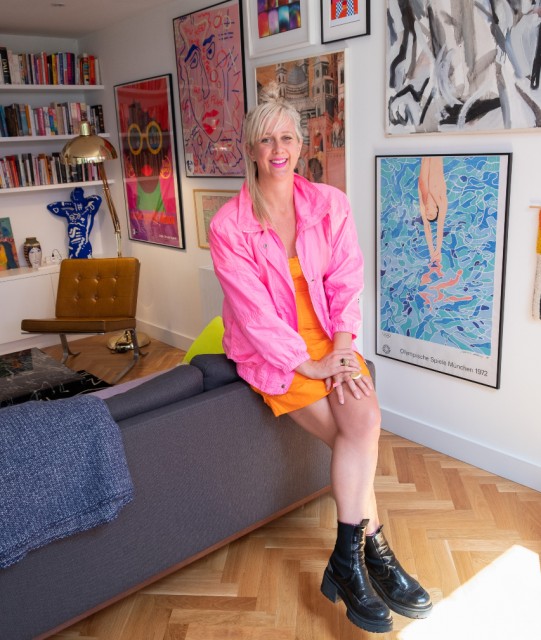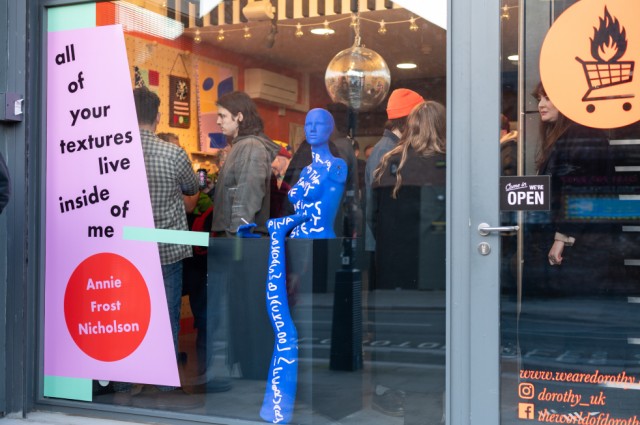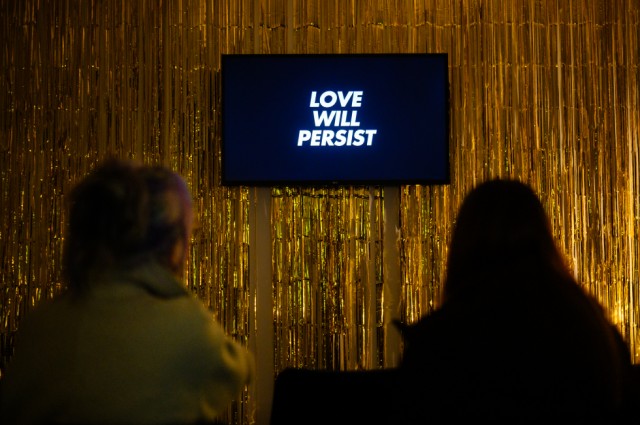The Big Interview: Annie Frost Nicholson

“The offering that I give is the work itself.” Mike Pinnington speaks to Annie Frost Nicholson about how, through art, she found a way through indescribable loss…
“There’s constantly this feeling of being caught between life and death.” I’m speaking with artist Annie Frost Nicholson, about inspirations and influences, specifically about her recent devouring of some of the writings of W. G. Sebald and, more broadly, her ongoing love of Sophie Calle and Jenny Holzer. The latter pair are artists with whom Nicholson shares affinities; and, when we speak, she’d recently returned from seeing Calle’s large-scale Paris exhibition.
Her own work, meanwhile, is currently on display at design studio, Dorothy, in Liverpool’s Baltic Triangle, in an exhibition titled All Your Textures Live Inside of Me. It is, says the artist, who lost her her mum and sister in an accident in 2011, “like an ode to grief and memory, and the continuum between life and death.” It is, in a way, a story of necessity rather than choice, a recounting and a consideration of her journey in dealing with the “indescribable loss” of loved ones, at this point in her life and career.
“If I think back to my art school days, [my work] was always about intimacy, and relationships and connections between people, and the human condition,” she elaborates. “But I’d never had any experience of grief. When this happened, the grief, the weight of the grief I felt, was at the forefront of everything really and so, initially, a lot of the work that I was making was for me. It was like, sketchbook works to find my way through it, and find my way through the pain of it.”

Then came a shift to something much more public, more explicitly concerned with processing trauma. This gave rise to the rather magnificent Fandangoe Discoteca, a disco booth – designed ‘to shake out your grief and help you maintain daily mental health’ – which, up until very recently has been bringing vibrancy, colour and banging tunes to the nearby Royal Albert Dock. It’s artwork as empathetic, generous act, I put to her, an opening of the door.
“You know,” she says, “having been through it myself and knowing that, being prescriptive, it doesn’t work; telling someone how to do something, particularly how to move through pain, you have to follow the need of the person who is in pain. So I’ve got a lot of experience of what to do, and what not to do, from having lived it. And so hopefully, when it goes into the world, the personal work that I make is an invitation to share a space rather than a prescriptive kind of doctrine. It’s an offering, I guess.”
Music and dance – so intrinsic to navigating life, especially in our formative years – informs much of her thinking, if not always being obviously contained by or present in the final work. “Yeah,” she tells me, “music really is a kind of portal back to a time, and I can remember almost every feature of hearing something for the first time, because in those formative years, it would have been with my sister who, you know, had access to the music and the ways to play it. Because I was a kid; I had pocket money for singles and stuff, but wasn’t collecting music. And also, that era; you’d hear it on the radio, or record it off of the radio. You couldn’t get it at your fingertips like you can now. So there was a part of that that was a real discovery as well. It felt like a real adventure, like an active seeking out of things.”
Time spent with her sister discovering music and how to be in the world is prominent in the Dorothy exhibition which, appropriately, has a disco ball, record player and a copy of Rom Boyd’s Dancing on Borrowed Time, an Italo Disco EP put together especially for the fundraiser for the Discoteca. But the vast majority of the work on display has been made with the exhibition in mind. “There’s quite a lot going on; lots of mixed media pieces. I’ve lived a long time quite close to the dead, so the past 10 or 12 years have been [about] a real closeness to keeping those people alive, and to sort of trying to work out acts of survival without those people.”

The first gallery exhibition of her career so far, when we speak ahead of its opening, Nicholson confesses to having some jitters. “It feels much more transparent than almost anything I’ve done. I don’t really do this as much, so I’m really nervous. I think this feels like a few layers that have been stripped back, and I’m quite like, you know,” she says, gesturing feeling anxious. But, she continues, “it’s a very new era but, you know, the right one, I think the right path.”
First impressions of the show is that it really pops – across print, collage, film, painting and more, there is a lot of colour, a lot of layers. Once you’ve absorbed its joyous, multi-sensory, tactile nature, however, there is much here that resonates. Sticks with you. Text, as in the work of one of Nicholson’s touchstones, Jenny Holzer, looms large. Towards the end of her Rough Trade publication, Tender Hearted Bold Moves, comes the line: “You Never Know When Your Next Or Your Last Dance Is Coming.” On a collage, the typed legend: “The ghosts I’m carrying with me are neither to be feared nor pitied.” And on paintings: “I think of you in my worst times and it feels like home.” On another: “Dancing on borrowed time.”
There it is again, that universality, the dance of death. So people will, no doubt, find meaning from their own lives, and crumbs of comfort, in the exhibition. Love and joy, as well as grief and death, are present; and, after all, these are things to which most of us can relate. “Absolutely. You think ‘this is made as a response to personal experience,’ but within that, there is a such a universality. And I think, as you move through working with a public for a long time, you hopefully learn how to speak to people that you don’t know, but also how to hold your own story. I mean, it’s an eternal balance.”
I ask about this “eternal balance” and whether, because she’s flipping the taboo around death, and making it a conversation that’s allowed, even encouraged to be had, is there a danger of becoming a kind of receptacle for other people’s feelings. “I think, if you’re opening up grief and trauma for other people, you also want to ensure that you hold that in a really respectful way for someone. So, you know, that has been something that we’ve worked on. There’s a team that I’m not involved in, and I’m really happy to not be involved in that. I’m not a social worker or a therapist; the offering that I give is the work itself.”
Ultimately, she reflects, the exhibition and her wider work is “offering a meditation on life and death, which many artists do. Hopefully that would encourage people to come to the show and bring someone with them and talk about it. And, you know, they can honour their dead and honour their experiences.”
Mike Pinnington
Annie Frost Nicholson: All Your Textures Live Inside of Me continues at Dorothy until Friday. You can read more about the exhibition and see a selection of the work on display here. You can see more of Annie Frost Nicholson’s new works here
Images, from top: AFN portrait: © Tara Darby; installation photography courtesy Dorothy and © Pete Carr





